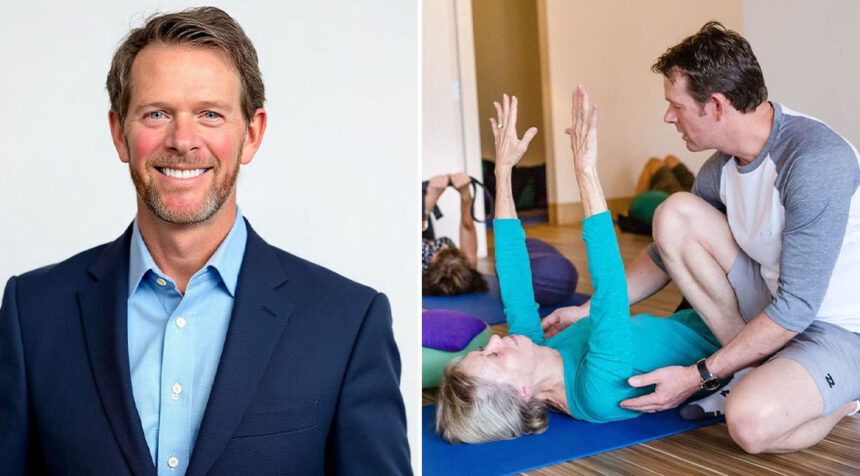Often, we think of personal records as the act of lifting a heavier weight or making that extra rep, but for many, being stronger than yesterday simply means reducing our pain and improving our mobility. Jeff Bailey has dedicated his life to yoga since 1985 and has taught more than 13,000 classes in the process of developing “Avita Yoga”—a discipline that is firmly focused on restoring joint health and all-round mobility.
Bailey found himself wrestling with some of the theories behind traditional yoga right from the start. “The word ‘yoga’ actually means ‘to join,’” he tells M&F ahead of June 21’s National Yoga Day. “If yoga means to join, then why did we spend an hour pulling ourselves apart,” he jokes. Bailey’s inquisitive nature led him to question everything that he was learning from his own instructors, evolving ‘Avita’ yoga along the way. In his mid-twenties, Bailey began to share his hard-earned wisdom. “I loved teaching yoga because I could see it releasing tension and naturally opening hearts and minds,” he reflects. “Just as mine was being opened.”
Avita is an accessible strand of yoga because it takes the emphasis away from posing. “We use shapes, not poses,” he explains. “To reveal the blockages and restrictions in and around the joints where the problems reside.” Formal studies back this up. Studies have shown that just 12 minutes of yoga per day could improve bone mineral density in the spine, hips, and femur making it a great way to combat osteoporosis.
Those who worry about being asked to stretch themselves into the next zip code can take relief because Avita understands the limitations of the human body, especially as we mature. “Muscles are designed to release, relax, and extend,” says Bailey. “But stretchability is not a characteristic of muscles. If overdone, it can lead to instability and disorganization. Stretching is part of the quest to “advance” a pose, and as long as youth is on our side, it can work, but in my experience it’s the wrong goal and can lead to difficulties later in life.”

You are Not ‘Too Tight’ or ‘Too Stiff’ to Start Avita Yoga
Television scenes of bright young things twisting themselves into a pretzel on the yoga mat have led to the notion that we need to master our mobility before signing up for a session. “Which is true for many styles of yoga,” says Bailey. “Avita Yoga is very different, and consistent practitioners achieve fantastic results from it because we don’t use traditional stretching methods. We use doable shapes to reveal and release the fascial restriction around the joints. In doing so, the joint itself undergoes sustainable pressure, which helps alleviate arthritis and improve mobility. This practice differs significantly from attempting to generate flexibility in bodies that are often resistant to stretching.”
In Avita Yoga, students move according to the natural back-and-forth function of muscles. “It’s called reciprocal innervation,” explains Bailey, “And we rely on it in various shapes to identify and resolve restrictions in the fascia and the compensation patterns they produce. When one group of muscles contracts, the opposing muscles extend. When we get very honest about this movement to isolate joint dysfunctions, amazing things start to happen. We find that we have an enormous amount of inner resistance, which is why we don’t do repetitions. Instead, we aim to utilize every muscle fiber fully to achieve an equal degree of release in the antagonistic muscles, while targeting the related joints and bones. It’s more straightforward than it sounds, and fortunately, results come quicker than our ability to comprehend what’s happening as we practice.”
Still, those who do want to learn the finer details will be heartened to know that Bailey is releasing a book that covers all this.
‘Mobility for Life —Healthy Joints, Strong Bones, and a Peaceful Mind with Avita Yoga’ is available to pre-order now!
Get in Shape with Jeff Bailey’s Avita Yoga
In his new book, Bailey takes a hollistic approach to improving mobility and reducing pain, even going as far as to offer nutritional advice to lower inflammation and boost energy. As for getting started with Avita, Bailey’s message is simple.
“The shapes I recommend are the ones that most directly reveal and resolve the limitations at their source,” he says. “What’s holding you up? Is it a shoulder, hip, knee, or ankle? We start with the most troubling body part and generalize to the other joints along the way. I appreciate it when people experience results quickly, as it fosters trust in a process we have been taught to avoid. Pain is not the problem. It’s the messenger, and if we don’t try to kill it, it will lead us to the problem. This is important because with chronic situations, the pain and problem are rarely in the same place. This is why we use shapes to bring the problems to light so we can resolve them. We don’t analyze or intellectualize the process. We let the shape do the work while we observe the sensation from a place of peace. This is how we know it’s working for us.”
Still, Bailey’s beliefs do have a scientific basis. “Arthritis is nothing but a toxic environment that leads to the degradation of the joint,” he explains. “Thoughtful and consistent pressure purifies the synovial fluid and initiates the remodeling of the joint surfaces. While it requires consistent practice, it takes far less time than many think. Our bodies want to be healthy. My book teaches a method for slowing down and doing less to gain more. When we stop pushing ourselves for fitness, we can make time for lasting health and inner peace.”
Recover With Jeff Bailey’s ‘Legs Up The Wall’ Yoga Pose
The first thing to understand is that Avita does not seek perfection in making any of its shapes, and Bailey tells M&F that this particular shape offers contrasting benefits. “Looking for more peace and resiliency?” he asks. “Want to give your heart a gentle challenge while slowing it down? Here’s a shape called ‘Legs Up The Wall’. It’s one of the basic shapes from which many others originate, allowing us to target the knees, feet, toes, arms, hands, shoulders, and hips. Please do not discount the many benefits by its seemingly simple nature.”

- Lie on your back with feet toward a wall
- Support your head with a pillow (optional)
- Position hips 10” to 15” away from the wall so the knees extend effortlessly and fully, and the tailbone is on the floor.
- Raise your legs, resting the feet on the wall.
- Close your eyes and feel the position, and the sensation this brings.
- Slowly turn your head to one side, feel the restriction in the turn for a moment. Rest and let this shape work for you.
- After a few minutes, turn your head to the other side, identify the limitation, and relax.
Bailey says that you must put yourself in a doable, sustainable shape in order to relax and release areas of tension. “At first, many cannot have their legs up the wall for more than a few minutes,” notes Bailey. “Often, the more athletic cyclists, runners, and weightlifters have a tough time with it because there is so much rigidity in the feet, knees, hips, and lower back. These areas greatly benefit from the position. If the wall is too demanding, start with your legs over a chair or ottoman and work to the wall over time.”
Avita Yoga Offers the Potential For Multiple PRs
It’s not just the prospect of a pain free day that Avita offers. The discipline has also improved other essential areas of life such as sleep. “Most practitioners report having less anxiety and more peace and calm,” reports Bailey. “Despite our best intentions to keep moving, I have found that relying solely on the movements we do today to keep us moving tomorrow is not enough. We must delve deeper to uncover the limiting beliefs, patterns, and blockages. This is our yoga! You could even say, it’s the purpose of a lifetime—to liberate ourselves from the inside out. And this takes courage, but it’s worth it! Because anytime we venture into new inner territory and willingly let the pain and resistance come to the surface, good things happen.”
For more information on Avita Yoga, click here!








